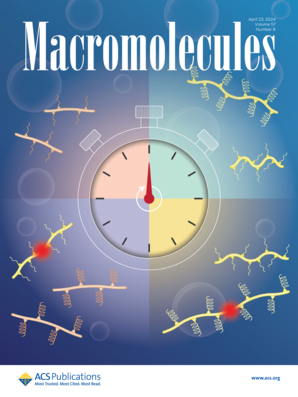用强化学习重新设计具有特定性质的聚合物
IF 5.1
1区 化学
Q1 POLYMER SCIENCE
引用次数: 0
摘要
设计具有特定性能的聚合物对于航空航天,汽车和建筑等行业至关重要,在这些行业中,高屈服强度是稳定性和性能所必需的。传统上,聚合物的设计依赖于几十年的反复试验,这些试验既耗时又低效。虽然最近计算方法的进步已经成为聚合物设计的有前途的工具,但它们主要集中在性能预测或无偏聚合物生成上,并没有完全朝着满足特定性能标准的新型聚合物结构的定制设计发展。为了加速对新型高性能聚合物的探索,我们提出了聚合物生成的强化学习(RLPolyG),这是一个集成的面向目标的探索工作流程,用于具有特定性质的聚合物从头设计。该框架采用了预测聚合物性能的正演模型和通过强化学习优化的逆模型,以生成具有特定屈服强度的聚合物。我们的正演模型在预测屈服强度方面的R2为0.84,使得逆演模型能够生成4991种新型候选聚合物,平均屈服强度显著提高45.20%。我们进一步根据合成可达性(SA)分数和降解性对候选聚合物进行筛选,确定了具有良好合成可行性和降解性能的3099聚合物。最后,我们通过分子动力学(MD)模拟验证了9种性能最好的聚合物,结果表明,预测值与MD验证值之间的平均相关误差为14.64%。这项工作展示了使用强化学习来改变聚合物设计的潜力,为探索广阔的聚合物空间和加速发现满足特定工业需求的材料提供了系统和有效的途径。本文章由计算机程序翻译,如有差异,请以英文原文为准。

De Novo Design of Polymers with Specified Properties Using Reinforcement Learning
Designing polymers with specified properties is crucial for industries such as aerospace, automotive, and construction, where high yield strength is necessary for stability and performance. Traditionally, the design of polymers has relied on decades of trial-and-error experiments that are time-consuming and inefficient. While recent advancements in computational methods have emerged as promising tools for polymer design, they predominantly focus on property prediction or unbiased polymer generation and do not fully progress toward the tailored design of novel polymer structures that meet specific performance criteria. To accelerate the exploration of new high-performance polymers, we proposed Reinforcement Learning for Polymer Generation (RLPolyG), an integrated goal-oriented exploration workflow for de novo polymer design with specified properties. This framework employs a forward model for predicting polymer properties and an inverse model optimized via reinforcement learning to generate polymers with specific yield strength. Our forward model achieved an R2 of 0.84 in predicting yield strength, enabling the inverse model to generate 4991 novel polymer candidates, resulting in a significant 45.20% improvement in average yield strength. We further screened these candidates based on synthetic accessibility (SA) scores and degradability, identifying 3099 polymers with excellent feasibility for synthesis and degradation performance. Finally, we validated the nine top-performing polymers through molecular dynamics (MD) simulations, which showed an average related error of 14.64% between the predicted and MD-validated values. This work demonstrates the potential of using reinforcement learning to transform polymer design, providing a systematic and efficient pathway to explore the vast polymer space and accelerate the discovery of materials tailored to meet specific industrial needs.
求助全文
通过发布文献求助,成功后即可免费获取论文全文。
去求助
来源期刊

Macromolecules
工程技术-高分子科学
CiteScore
9.30
自引率
16.40%
发文量
942
审稿时长
2 months
期刊介绍:
Macromolecules publishes original, fundamental, and impactful research on all aspects of polymer science. Topics of interest include synthesis (e.g., controlled polymerizations, polymerization catalysis, post polymerization modification, new monomer structures and polymer architectures, and polymerization mechanisms/kinetics analysis); phase behavior, thermodynamics, dynamic, and ordering/disordering phenomena (e.g., self-assembly, gelation, crystallization, solution/melt/solid-state characteristics); structure and properties (e.g., mechanical and rheological properties, surface/interfacial characteristics, electronic and transport properties); new state of the art characterization (e.g., spectroscopy, scattering, microscopy, rheology), simulation (e.g., Monte Carlo, molecular dynamics, multi-scale/coarse-grained modeling), and theoretical methods. Renewable/sustainable polymers, polymer networks, responsive polymers, electro-, magneto- and opto-active macromolecules, inorganic polymers, charge-transporting polymers (ion-containing, semiconducting, and conducting), nanostructured polymers, and polymer composites are also of interest. Typical papers published in Macromolecules showcase important and innovative concepts, experimental methods/observations, and theoretical/computational approaches that demonstrate a fundamental advance in the understanding of polymers.
 求助内容:
求助内容: 应助结果提醒方式:
应助结果提醒方式:


